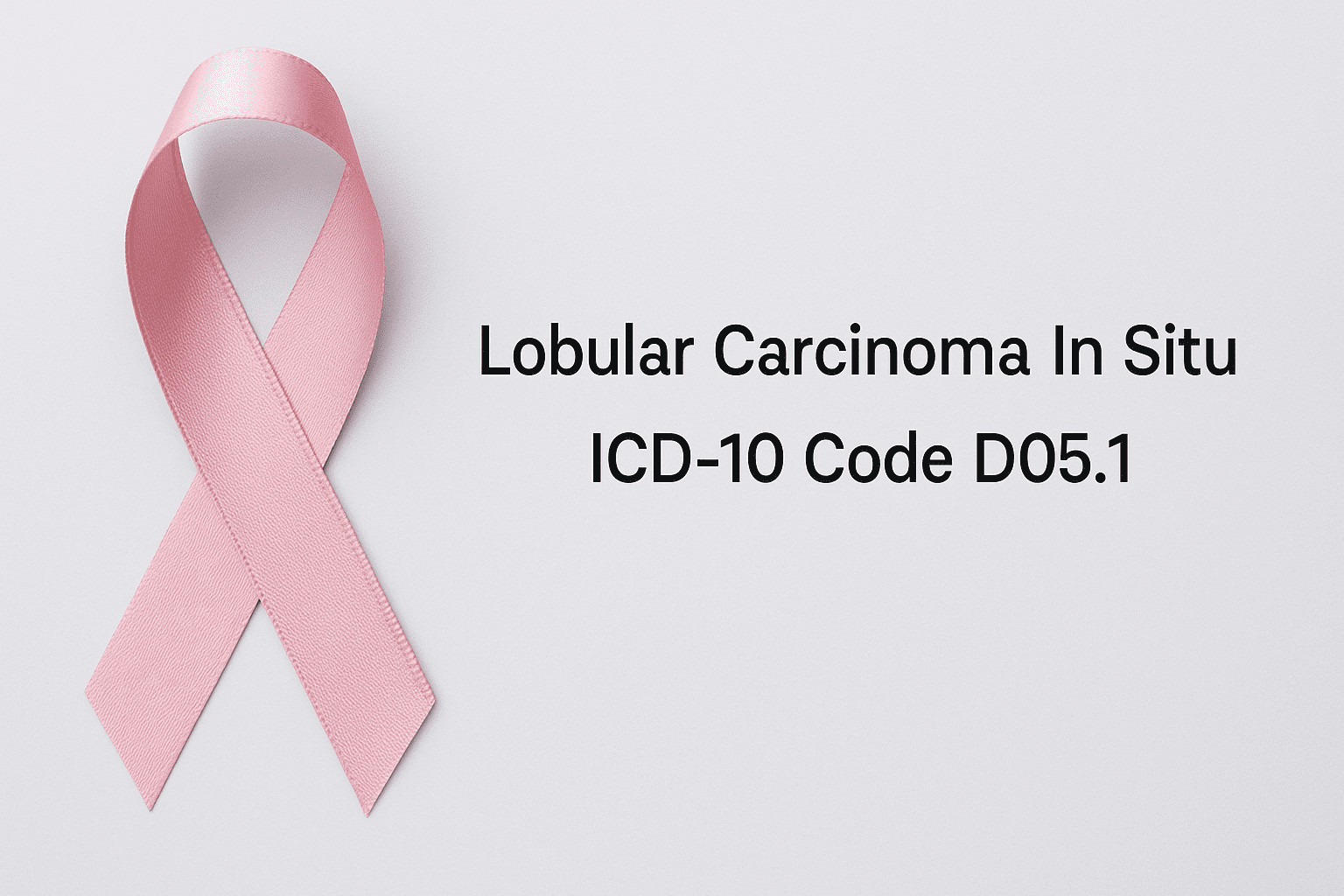Updated on: July 23, 2025
Lobular Carcinoma In Situ (LCIS) is a non-invasive neoplastic lesion confined to the lobules of the breast. It is not considered true breast cancer but rather a marker of increased breast cancer risk. Most LCIS cases are detected incidentally during biopsies for other abnormalities.
ICD-10 Code D05.1: Explanation
-
D05 = Carcinoma in situ of the breast
-
.1 = Lobular type
-
Used when LCIS is diagnosed in either breast, and the specific quadrant or laterality is not documented.
🧠 Remember: LCIS is non-invasive and should not be coded as malignant neoplasm (C50 series).
Other In Situ Breast Carcinoma ICD-10 Codes
| ICD-10 Code | Condition |
|---|---|
| D05.0 | Lobular carcinoma in situ, nipple |
| D05.1 | Lobular carcinoma in situ (general) |
| D05.7 | Other specified in situ carcinoma |
| D05.9 | Unspecified carcinoma in situ of breast |
🔍 Use D05.1 when LCIS is confirmed but further site detail is absent.
When to Use D05.1
Use D05.1 for:
-
Confirmed diagnosis of LCIS via biopsy
-
No mention of quadrant or location within the breast
-
Screening or incidental findings (e.g., mammogram, core needle biopsy)
-
Both unilateral and bilateral cases (unless specifically documented, in which case use additional laterality codes)
Sample Clinical Note:
“Routine mammogram followed by biopsy revealed LCIS. No palpable mass. No signs of invasion on imaging. Patient referred to high-risk breast clinic for surveillance.”
How to Improve Coding Specificity
Although D05.1 is valid, aim to document:
-
Laterality (right or left breast)
-
Quadrant or region if visible on imaging
-
Personal/family history of breast cancer
-
Hormonal receptor status if known
-
Surveillance vs excision management plan
More detailed documentation enables better care planning and more accurate risk-adjusted coding.
Commonly Paired ICD-10 Codes
| Condition | ICD-10 Code |
|---|---|
| Personal history of LCIS | Z85.3 |
| Family history of breast cancer | Z80.3 |
| Genetic susceptibility (BRCA) | Z15.01–Z15.03 |
| High-risk screening (surveillance) | Z12.31 |
| Mammogram abnormal findings | R92.0–R92.8 |
| Breast density | R92.2 |
Clinical Workflow for LCIS
-
Screening detection: Mammography/ultrasound
-
Diagnostic biopsy: Core needle or excisional biopsy
-
Pathology confirmation: Non-invasive lobular cells
-
Clinical discussion: Risk vs intervention
-
Plan: Monitoring vs prophylactic options (e.g., tamoxifen, surgery)
Because LCIS does not typically present with a lump or pain, documentation relies heavily on imaging and pathology. DocScrib’s AI scribe ensures these data points are captured and coded correctly.
Management Options for LCIS
-
Surveillance: Annual mammograms or MRIs
-
Chemoprevention: Tamoxifen or raloxifene
-
Surgical options: Rare; considered for high-risk patients or patient preference
-
Genetic testing: Especially with family history of breast cancer
Documentation of the chosen strategy is important for accurate care coordination and payer alignment.
How DocScrib Simplifies LCIS Documentation
With early-stage conditions like LCIS, missed details can delay follow-up or impact billing. DocScrib:
-
Captures real-time biopsy and imaging notes
-
Flags laterality or quadrant if dictated but undocumented
-
Suggests ICD-10 and CPT codes based on provider narration
-
Integrates clinical decision support (CDS) for breast cancer risk workflows
👉 See how DocScrib transforms oncology documentation
Reimbursement and Risk Adjustment Insights
-
D05.1 is not a Hierarchical Condition Category (HCC) code but still affects quality reporting
-
Key for tracking high-risk breast cancer populations
-
Should not be confused with malignant neoplasm (C50.xx), which triggers entirely different billing pathways
📌 Payers may deny claims if LCIS is incorrectly coded as invasive cancer.
Frequently Asked Questions
Is LCIS considered breast cancer?
No. LCIS is not invasive cancer. It is a risk marker, not a malignancy.
What is the difference between LCIS and DCIS?
-
LCIS (D05.1) arises in lobules and is considered a risk factor
-
DCIS (D05.0) arises in ducts and is often treated more aggressively
Should I document family history with LCIS?
Yes, especially if BRCA testing is planned. Use Z80.3 for family history and Z15.01 for genetic susceptibility.
Conclusion
ICD-10 Code D05.1 is used to document Lobular Carcinoma In Situ when breast laterality or quadrant is not specified. Accurate documentation of LCIS is critical to guide patient surveillance, risk-reduction strategies, and long-term cancer prevention. With the help of AI tools like DocScrib, clinicians can easily track and document LCIS findings while focusing on care.
Need smarter oncology documentation support for your practice?
👉 Book a free demo with DocScrib now
